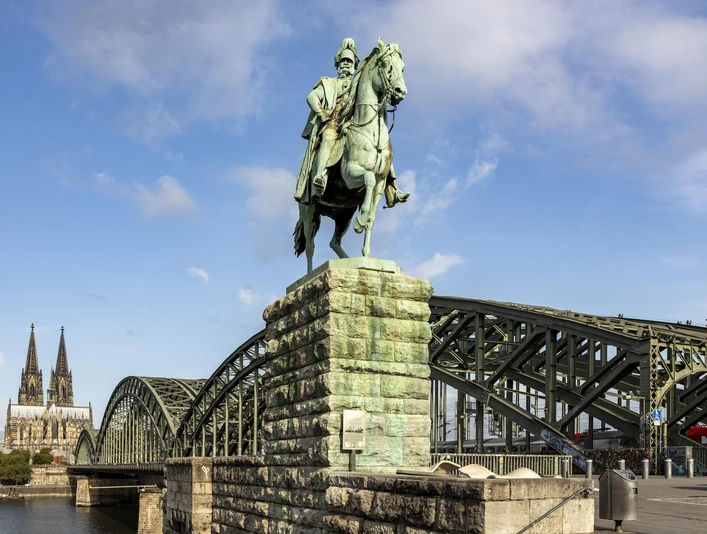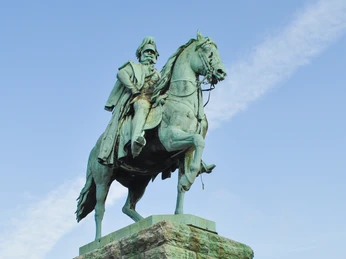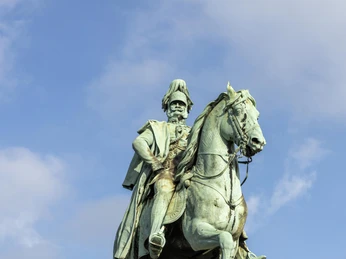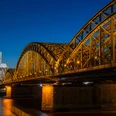- Photos & Map
How would you like to arrive?
- Details
- Useful Information
- Nearby
Emperor Wilhelm I is said to have been down-to-earth and humorous. Various anecdotes circulate about both qualities, one of which dates back to his return to Berlin after the Franco-Prussian War of 1870–1871. During the celebrations, a young officer lost his helmet in the crowd. The Emperor noticed it, picked up the helmet, and handed it to the astonished officer: “Here, my young friend, the helmet of a German soldier belongs on the head, not on the ground.”
In honor of this first German Emperor, numerous monuments were erected in Germany, including 63 equestrian statues. His equestrian statue in Cologne, located on the right bank of the Rhine on the Hohenzollern Bridge, is the first and still preserved one, dating from 1867. If you want to take a closer look at it, your path will lead you from the cathedral over the Hohenzollern Bridge, past the famous love locks, to the Deutz side.
Emperor Wilhelm I sits in a majestic pose on the horse, wearing a military uniform. All of this underscores his significance as a statesman and military leader. The monument was inaugurated and unveiled in 1867, originally located at the portal of the old cathedral bridge, which was replaced by the Hohenzollern Bridge in 1911.
Fun Fact: Wilhelm I ordered the monument to be unveiled at night in 1867 as he was not fond of statues. He preferred to avoid attention on his person.
Counterarguments focused on the opportunities for reflection: Instead of simply removing historical contexts, the monument in the public space could rather encourage critical discourse.
Ultimately, a compromise was reached towards contextualization: Information panels are to illuminate the critical aspects of the first German Emperor's policies. Thus, a monument becomes more of a place of learning than a mere glorification of the past.
On the path to the Empire were the German Confederation after the Napoleonic Wars, the Revolution of 1848/49, the political achievements of Otto von Bismarck, and three wars – the Danish-Prussian War, the Austro-Prussian War, and the Franco-Prussian War. Wilhelm I was proclaimed German Emperor in the Hall of Mirrors at Versailles on January 18, 1871, with Bismarck becoming Chancellor.
In honor of this first German Emperor, numerous monuments were erected in Germany, including 63 equestrian statues. His equestrian statue in Cologne, located on the right bank of the Rhine on the Hohenzollern Bridge, is the first and still preserved one, dating from 1867. If you want to take a closer look at it, your path will lead you from the cathedral over the Hohenzollern Bridge, past the famous love locks, to the Deutz side.
Majestic, Military, Right Bank of the Rhine
The equestrian statue of Wilhelm I is made of bronze and stands on a massive granite base. It was created by the renowned sculptor Friedrich Drake.Emperor Wilhelm I sits in a majestic pose on the horse, wearing a military uniform. All of this underscores his significance as a statesman and military leader. The monument was inaugurated and unveiled in 1867, originally located at the portal of the old cathedral bridge, which was replaced by the Hohenzollern Bridge in 1911.
Fun Fact: Wilhelm I ordered the monument to be unveiled at night in 1867 as he was not fond of statues. He preferred to avoid attention on his person.
Debate on Its Dismantling
In 2022, a public debate erupted regarding the equestrian statue of Wilhelm I and how to handle the historical role of the Hohenzollern monarchs today. Because Emperor Wilhelm I is also associated with German colonial policy and military expansion, proponents of its dismantling argued that the equestrian statue should not remain in the public space due to its symbolic connection with imperialism and anti-democratic developments.Counterarguments focused on the opportunities for reflection: Instead of simply removing historical contexts, the monument in the public space could rather encourage critical discourse.
Ultimately, a compromise was reached towards contextualization: Information panels are to illuminate the critical aspects of the first German Emperor's policies. Thus, a monument becomes more of a place of learning than a mere glorification of the past.
Regarding its significance: Wilhelm I – Symbol of Germany's Predominance
Emperor Wilhelm I was the first German Emperor and King of Prussia – known for his conservative policies. With the establishment of the German Empire in 1871, the process of bringing together independent German states under Prussian leadership in the 19th century was completed. Wilhelm I thus became a symbolic figure of German unification and Prussian predominance in Germany.On the path to the Empire were the German Confederation after the Napoleonic Wars, the Revolution of 1848/49, the political achievements of Otto von Bismarck, and three wars – the Danish-Prussian War, the Austro-Prussian War, and the Franco-Prussian War. Wilhelm I was proclaimed German Emperor in the Hall of Mirrors at Versailles on January 18, 1871, with Bismarck becoming Chancellor.
Excursion: The Hohenzollern Dynasty
The full name of the first German Emperor was Wilhelm Friedrich Ludwig of Prussia, and he came from the significant Hohenzollern dynasty, which has produced many other famous German "Friedrichs," three of whom also sit astride their horses along the Hohenzollern Bridge: Emperor Friedrich III, Emperor Wilhelm II, and King Friedrich Wilhelm IV. They were reinstalled after World War II following many discussions, whereas the portal constructions and bridge towers of the Hohenzollern Bridge were dismantled in 1958.Useful Information
Eligibility
for Groups
for Class
for families
for individual guests
Suitable for Pushchair
Payment methods
Entrance Free
Parking facilities
The walk from Cologne main station takes about 12 minutes.
Our recommendations
Nearby



